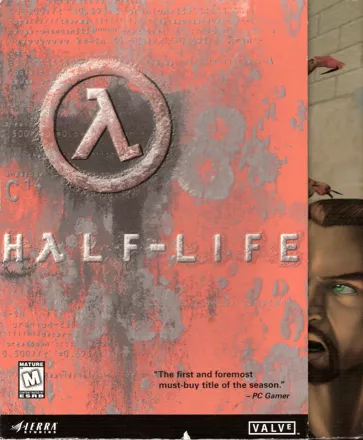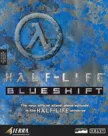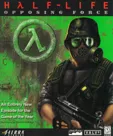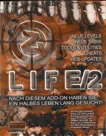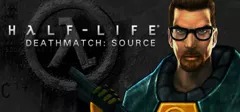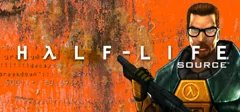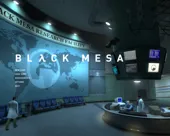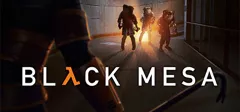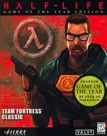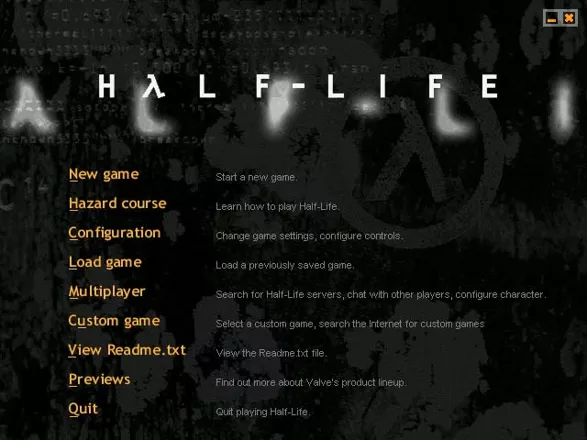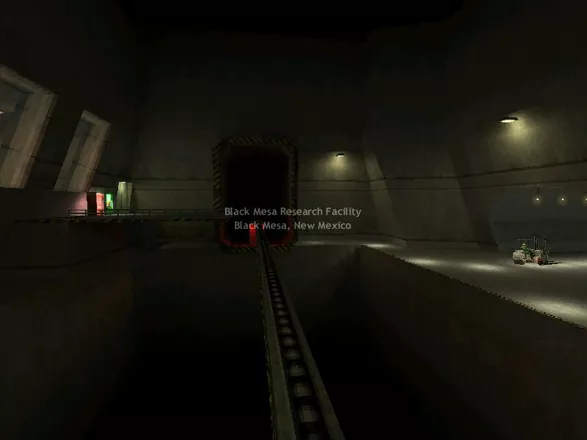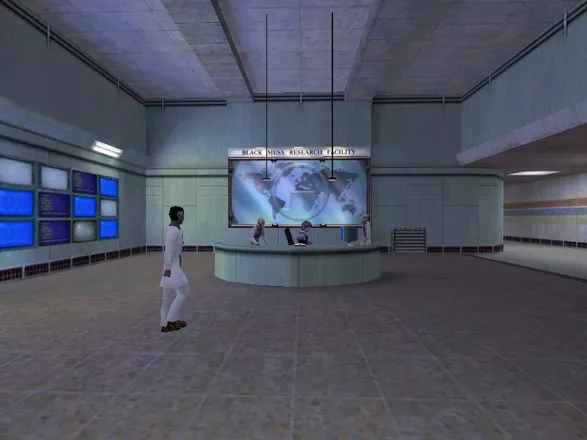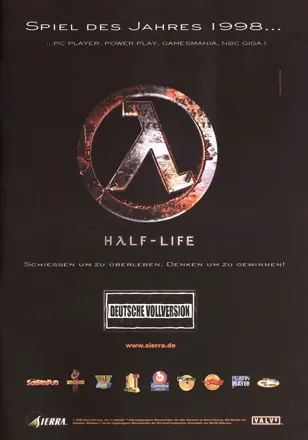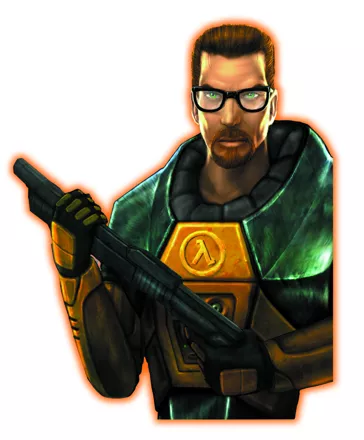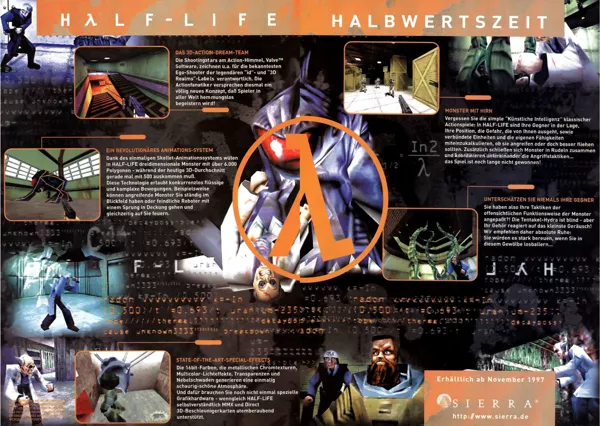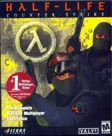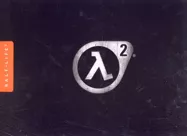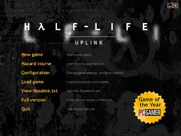Half-Life
-
 Half-Life
(2001 on
PlayStation 2)
Half-Life
(2001 on
PlayStation 2)
Description official descriptions
The Black Mesa Research Facility is an ultra-secret laboratory under a government contract to conduct top-secret and extremely volatile experiments. The scientist Gordon Freeman is a Black Mesa employee. One morning, as usual, he pits his way to the research facility for a run-of-the-mill experiment. However, Gordon comes to realize that it might not be as ordinary as he thought. Odd things happen as he makes his way to one of the Black Mesa test chambers. Even stranger things happen when he begins to move the test sample towards the anti-mass spectrometer.
At that moment, everything goes horribly wrong. Aliens from the dimension Xen suddenly invade the facility, injuring or killing many of the employees. Soon afterwards, marines arrive to contain the situation by killing the aliens as well as the surviving human witnesses. Gordon understands what that means: he will have to fight his way through both aliens and marines to get to the top of the Black Mesa complex and to freedom.
The story of Half-Life is told entirely in-game: everything is seen through the eyes of the protagonist. Most story elements unfold via scripted sequences, triggered by the player reaching a certain area. If other characters have information to reveal, they address Gordon directly. The Black Mesa complex in the game is made up of both distinct levels which progress in a linear fashion as well as hubs where backtracking may be required to unlock further areas.
The game's weapon arsenal mostly consists of realistic weapons like pistols, machine guns and explosives, but there are also futuristic energy weapons developed at Black Mesa as well as organic weapons acquired from the invading aliens. Most weapons feature an alternate firing mode.
Enemies fall into two categories: aliens and human soldiers. While most of the aliens are not very bright, the humans display some relatively advanced artificial intelligence: they seek cover, retreat when hit and try to drive the player from his cover by throwing grenades. Some of the alien enemies cannot be killed by normal means. The environment must be used against them instead, going with a general tendency of the game to alternate the combat with environmental puzzles.
As of the 25th Anniversary Update from 17 November 2023, the Steam version of Half-Life includes content from Half-Life: Uplink as well as sprays and maps from Half-Life: Further Data V.1.
Spellings
- 半条命 - Simplified Chinese spelling
- 戰慄時空 - Traditional Chinese spelling
Groups +
- 3D Engine: GoldSrc
- BestSeller Series (Cendant / Havas / Vivendi Universal) releases
- BPjS / BPjM indexed games
- Gameplay feature: Drowning
- Games referenced in movies
- Games with official modding tools
- Games with officially released source code
- Half-Life universe
- Middleware: SDL
- Setting: 2000s
- Setting: Future now past
- Weapon: SPAS-12
Screenshots
Promos
Videos
See any errors or missing info for this game?
You can submit a correction, contribute trivia, add to a game group, add a related site or alternate title.
Credits (Windows version)
80 People (58 developers, 22 thanks) · View all
| Engine Programmer | |
| Engine Tools Programmer | |
| The Half-Life Team | |
| [ full credits ] | |
Reviews
Critics
Average score: 94% (based on 59 ratings)
Players
Average score: 4.3 out of 5 (based on 539 ratings with 30 reviews)
Still looks as fantastic as it was back in 1998
The Good
id Software rose to stardom in the Nineties when it released its highly successful Wolfenstein 3-D to the masses. If you see the id logo on the front cover, you know that you will be taking home with you an awesome first-person shooter. Hits such as Doom, Heretic, and Quake were being churned out every year. In 1998, Valve, a small company headed by a former Microsoft employee, released Half-Life, and in my opinion, it is a classic. A review I read in PC PowerPlay gave the game a whopping 98%. The only negative thing they said about this game was a connection between hunger and African children. It was Half-Life itself that revolutionized first-person shooters on the PC even further.
Right from the start of the game, I was surprised to find out that instead of a long cinematic showing Gordon Freeman traveling to the Sector C Test Labs on a train, you are free to move around the train yourself. You can even look out the windows to discover construction areas and security offices. Then, once you reach Sector C, you can either explore the area fully or go find your HEV suit. Freeman’s HEV suit is fantastic. Besides telling you how much health and ammo you have, it displays different warnings depending on the environment you are in. It even talks to you, too. With the suit in place, it’s time to enter the test chambers. There are no cinematics in the game; Valve wants you to be immersed in the game world as much as possible.
Eventually, there is a resonance cascade, which is caused when Freeman pushes a specimen in a scanning beam. A portal opens up between Earth and an alien world called Xen. As you progress through the game, you will hear aliens teleporting in your vicinity. The first of these are headcrabs, vortigaunts, and houndeyes. The player will encounter more aliens as they progress, and these can be dealt with using the variety of weapons on offer. They are divided into groups, with the basic ones such as the crowbar on the left, followed by military-grade weapons, then alien weapons and, finally, grenades and other explosives. Different weapons can be selected by using the mouse wheel or pressing one to five on the keyboard.
The security guards and scientists walking around at the start of the game are non-playable characters you have to deal with later. They can help you get into locked areas if you lure them to the door locks. What they won’t do is climb ladders, follow you through vents, or enter very dangerous areas. Both characters have little conversations with themselves if they get bored. You can call their services any time throughout the game, just not before you enter the test chamber. The earliest game I know that introduced the concept of NPCs was CyberMage: Darklight Awakening, but this was an overlooked game back in the day, and you can only talk to them, that’s all.
Another plus of Half-Life is the level design. There are many areas to explore, including offices, rail tunnels, control centers, outposts, and even Xen itself. They are interconnected with each other, and – unlike first-person shooters before it – they don’t require you to press a button to access them first. Some of the areas are littered with puzzles. My favorite is trying to launch an airstrike on the Gargantua. There are bosses you need to defeat from time to time, but it is not just a matter of “shoot to kill”.
In most chapters, the environments in which the player explores look amazing, especially the exterior in “Surface Tension”. For example, the player has to fight HECU soldiers along a cliff. The view of the New Mexico desert is breathtaking, with a little stream at the bottom and huge rocks surrounding it. “Xen” and “Interloper” are outside scenes, and the view looks really good. I enjoyed exploring the planet, shooting alien grunts in the process. In earlier chapters, offices and computer rooms can be entered while players are walking around Black Mesa. I was amazed at how much technology got crammed in the computer rooms, and how good it looks. Furthermore, the offices are clean and haven't got trash lying on the floor. They look better than my bedroom.
Like many games released on CD-ROM, the music is stored as audio tracks. The music in Half-Life is well composed, and what’s unique about each piece of music is that they don’t loop back to the beginning, and each piece only lasts for only two or three minutes. I like how some of them have that beat to them, such as the one played after you don your HEV suit. As for the sound effects, they are quite impressive. My favorite sounds come from the houndeye. When this cute creature sees you with its one huge eye, it sounds as if a door is opening. And as it emits shock waves you can almost hear Freeman screaming even though he is supposed to be silent.
If you’re new to first-person shooters, you want to compete on a hazard course before you start a new game. You will be assisted by a holographic image of a woman who teaches you how to run, jump, duck, shoot, perform long jumps, and climb ladders. It will take you about thirty minutes, given that you may fail at completing a task. You will also learn how to accomplish new tasks such as performing high jumps, using ladders, recharging your HEV suit and health at wall stations, and going around in the dark with a flashlight.
The Bad
I noticed a few bugs in the game, mainly concerning the non-player characters. In some situations, when they finish walking to wherever they want to go, they tend to do a little tap dance. I even remember, in the chapter “Office Complex”, one of the NPCs was walking around and died of a heart attack. Also, I remember in “Blast Pit”, when I opened a door, it seemed to drift out into space as long as it remained open.
The Bottom Line
Half-Life is a fantastic game. There is so much to do here - destroying aliens; restoring power to some areas; and interacting with both scientists and security guards, to make them get you access to locked areas. Most of the graphics are breathtaking, and an excellent soundtrack is heard while you play. There are certain aspects of the game that the player might enjoy doing.
Originally released for Windows in 1998, Half-Life also made its way onto Mac and Linux thanks to Valve themselves. This version - distributed on the Steam platform - is the same as the original retail version but without the flashy menu screens. There is also an updated Source port which I recommend you avoid; it contains too many bugs Valve couldn't be bothered fixing. If you love first-person shooters and you want to do something new, other than blast enemies all the time, give Half-Life a go.
Windows · by Katakis | カタキス (43087) · 2021
The Good
Half-Life represents another chain in the link that started in 1993, when Doom shipped without any sort of "High Scores" table.
Basically, the trend of shooter games towards realism, away from gimmickiness and "arcadeness", and into the a future where games get compared to movies as works of art and you don't wait for the punchline.
Immersion is the altar this game worships at. Not just great graphics or great sound or lots of polygons - immersion. Every aspect of Half-Life is engineered to create a world you can get lost in, from the level design, to the audio, to the overall concept of the game. It's still a shooter with the same fundamental rules as Doom - the way out of these elaborately crafted environments is still generally "shoot the crap out of everything" - but with various subtle touches that seem like nothing yet add up to everything.
It's hard to overstate how successful Half-Life is at what it does. Black Mesa is never anything less than a real place, filled with vending machines, garbage cans, querulous scientists, etc. Within the first few minutes, you get to see a locker room. Open the locker marked GORDON FREEMAN, and you see some of the main character's personal effects - including some books he's reading. The main character in this game reads books! A tiny detail, yet a complete paradigm shift.
You don't find weapons and ammo lying in the middle of the hallway in Half-Life, you find it in a place that makes sense (like a gun locker or a weapons cabinet). You don't open doors with brightly colored keys, you actually have to find a scientist or soldier and ask them to grant you access (which sometimes entails an argument). In one incident a guard started helping me in a gunfight, and yelled "got another one!" as he plugged a headcrab. Despite Half-Life's datedness, scripted moments like this still have an eerie power. For just a second, he's the player and you're an NPC in his game.
Half-Life is masterful in keeping the ugly, clunky machinery of videogaming off-screen. The game seamlessly transitions from level to level. No load screens. No cutscenes. The game just doesn't cut away. It keeps you locked inside the experience, like a movie. Again, the effect is subtle, but you definitely feel it. It's like an orchestra that effortlessly segues from section to section, versus one that has to stop and re-tune their instruments at the end of each movement.
The game has barely any story, but it gives you the ineluctable sense that there probably is a story, you just aren't around to witness it unfold. Not so much "this is a plotless game" as "gee, I wonder what I'm missing out on, wandering around empty hallways with my crowbar." The widely parodied, widely mocked decision to not have Gordon Freeman speak works really well, as you imagine your own voice and your own words flowing into silences in conversation.
The Bad
Half-Life is so overpowering as an experience that it took a while to sink in that I wasn't having that much fun.
A goofy, arcadey FPS like Quake kills Half-Life in enjoyment factor - and Quake's hardly an FPS benchmark par excellence.
Half-Life is just too clever for itself. It's filled with inventive ideas that just plain don't work in an FPS game. Too many times when you have to perform Lara Croft-esque jumps without seeing your feet. Too many places where you have to navigate instant-death tripwires with only a hazy idea of your proximal surroundings. Too many places where you're trying to push boxes around and they go unhelpfully skidding off in the wrong direction. It's like the game gets bored with being a groundbreaking FPS, and also wants to be a shitty version of Rayman.
And what's with the several million miles of air ducts you have to crawl through? Why? What's meant to be fun or enjoyable about that? I swear that half the game is spent hobbling through air ducts. Go fuck yourself for that one, guys.
Looking at Half Life in hindsight, You can see a real "cool stuff overload" coupled with a neglect to the basic principles that make gaming fun. Hit detection is seriously wonky. You're reaction when shooting isn't so much "eat death, hellscum!" as "man, I hope that last shot did damage". Overall, this game's action just isn't satisfying. The entire dynamic of the gameplay and weapons feels "off", like you're just slightly out of control of everything. And the game depends such ridiculous levels of mid-air finesse - I lost count of how many times I had to jump while crouching to fit into a tiny air duct - that it feels like you're playing a third person game hastily reprogrammed for first.
Gradually the illusion wears away, like a woman's makeup tearing. You'll see how facile and shallow much of the game is - how the bosses can be beaten by a chess-playing computer, how the enemy AI is full of holes, how the game has a tiny number of character models and keeps reusing them. It's like Being John Malkovich: The Game.
Half-Life pushed the FPS genre in directions it probably wasn't ready to go. It's an impressive exercise if you value games as artistry, or as visual experiences.
But if you value games as games? I'm not so sure.
The Bottom Line
It's an old, perhaps apocryphal story. Grigory Potempkin, lover of the Russian queen, was given the task of rebuilding the devastated towns along the river Dneiper. Rather than do this, he built a series of beautiful fake towns, with his own men playing the part of happy, well-fed peasants. They would smile and wave as the Empress passed by, and then rush on to populate the next fake town.
Half-Life is amazing to look at, even now. But don't look too hard, or too long. You'll notice the parts held together with duct tape and silly string.
Windows · by Maw (832) · 2015
The Good
I honestly don't know how everyone can be wrong about the exact same thing, but I suppose that's how you kill an American president back in the 1960's. I read over and over again that the best thing about Half-Life is the story. Well, it's a very average story: something goes wrong at a top secret facility and it's up to one guy to save the world from an alien invasion, even though the government tries to stop him. If you disagree, then what point could you make that would spoil the story? You can't , because the plot is paper thin. It's not like someone is someone's father, one someone is actually a ghost, or that someone you didn't think was a dude is actually a dude!! See, those are meaty stories, some with more meat on the bone than others.
Now, what it excels at is how to tell the story. By only using your protagonist's POV the entire story you are witness to how this common sci-fi story could play out practically in the real world. Gone are power-ups that spin around in mid-air. If you find weapons there is a reason why that weapon is there, as in being in a weapon lock up or near the body of a fallen soldier. Basically it's taking a movie and filling in all of the blanks when the camera isn't there to explain what happened. How did he get back to full health? Oh, he crawled around in back through the air ducts and so on. This idea of logic adds to the plausibility of the story, and thus our immersion into it.
Having every area bumped into smaller areas to facillitate numerous yet very short load times makes the game into basically one level that just continues on and on. But where Half-Life succeeds is in it's use of set pieces that punctuate the flow of this one, long level and makes the game memorable. So there isn't the dam level, or the commando assault on the surface level, or fighting the helicopter level; instead you remember it for the set piece and not a level, something that increases your immersion in this game greatly.
Immersion is important because the game attempts to let you experience all the things you'd ever wanted to do in games (or life, if you're really ambitious). Fight commandos, helicopters, tanks (I'm not sure, I finished the game half a lifetime ago), use homing RPG's... immersion makes the experience much more visceral, and therefore a much better gaming experience.
Another thing I found great about this game is how you identify with this guy, faceless save for the box art or any fan pic in which he is always holding the crowbar. By making him late in the beginning of the game and giving him the option of turning on the security alarm in the reception area makes him a guy like you and me; even though he works at a top secret government facility, it's crappy!
The Bad
Even though it tells the story well it really doesn't make much sense. So who is this G-Man guy? Why is he always behind bulletproof glass? How can this Gordon Freeman guy be late for work in the beginning and in the end be taking down highly trained extremely dangerous army operatives? Doesn't it cost a fortune to run (and clean) Black Mesa? Isn't it so big that you can see it from outer space, let alone at the side of the oad that borders it?
For Half-Life to be true Gordon Freeman has to be running from one coincidence to another, and in the end it's just too many: in Half-Life one guy saw/caused the beginning of the invasion, keeps running into the mysterious G-man, and in the end travels to another dimension. See, if there were cut scenes and some invisable camera was watching secret proceedings that weren't privvy to common knowledge then you can accept that. This device hurts the believability of the game, and as such the story. In that case, how can the story "rock"?
The NPC's really weren't that thrilling (unlike DOOM3, there aren't any Asians around waiting to be turned into zombies). Really they're just there to spout some exposition and then open a door. Back in the day on planethalflife there was a section called the Scientist Killing Club; this inspired me to play through the game again, only this time I would try to kill as many "innocent" NPC's as I can. You know, once they open a door you can kill anyone you want. What kind of story is that? That just means the NPC's role in Half-Life are really not that important.
It is too bad about the last third on Xen. I would have appreciated a shorter but better game. I think this is a case of making it longer just to satisy the common consumer and also making it harder just because you are getting close to the end. 2D platformers are 2D because they work well in 2D. I think with a well-thought out first and second half you're bound to be let down at the end. By the way, I've done both choices, but for what? The game ends either way.
The Bottom Line
Half-Life is worth playing but not worth worshipping. Games matured a bit with Half-Life, but this is definitely not a "thinking man's shooter" by any account. In retrospect Half-Life doesn't deserve all of the acclaim it received for its time, but then people thought Half-Life had an amazing story because people hadn't ever been told a story that well through a FPS.
It's funny that the one game that influenced Half-Life the most, DOOM, will then rip it off Half-Life in DOOM3: arriving late, being witness to the "resonance cascade", jumping through portals, and even another monorail ride!
In truth, it was unicorn b lynx who got me really thinking about games and also prompted me to get involved on this site, so it's all your fault. Myself, I got tired of reading "pwns" and "rox!" and "suks!"
Windows · by lasttoblame (414) · 2007
Discussion
| Subject | By | Date |
|---|---|---|
| Narrative, wait what? | Donatello (466) | Jul 15, 2012 |
| Sorry, Valve | xroox (3895) | Feb 12, 2009 |
Trivia
1001 Video Games
Half-Life appears in the book 1001 Video Games You Must Play Before You Die by General Editor Tony Mott.
Advertisement
Very early beta footage of the game, as well as interviews with some of the programmers, is available on the Diablo expansion pack Hellfire, released by Sierra a full year before the game ever shipped. Sierra already had advertisements for Half-Life in many of their products back then.
Cancelled ports
- Half-Life, at one point, was completely finished for the Dreamcast console. Prima (the Official Strategy Guide folks) even had a Dreamcast-exclusive guide published. Unfortunately, the game wasn't published - probably due to the fact that SEGA announced that they would no longer produce new Dreamcasts. In certain circles of the Internet, a leaked copy can still be found and ran on a Dreamcast.
- A Macintosh port was in the works from Westlake interactive and reached beta before being cancelled because of concerns about responsibility for tech support.
Development
In its first finalized form, as it would have been published if the original release date was kept, Half-Life was nothing more than a total conversion of Quake with new enemies and levels. In the one additional year spent on development the game transformed into the form that led it to critical and commercial success.
Engine
Half-Life was released a full year after Quake II and it's a common belief that it was based on the Quake II engine. This is not true. It is based on the original Quake engine and it's more than fair to say that it was modified beyond recognition by the Valve team. Amongst the additions were built-in 3D accelerator support, skeletal systems and shadow casting (the latter didn't make it into the game). Valve now refers to this engine as "GoldSrc". This is probably how the "Source" engine from Half-Life 2 got its name.
German version
There is a special German version which features robots as enemies, green blood instead of red and innocent people cannot be killed any longer. The robot design was outlined by Sierra's Germany division, then sent to Valve in Seattle, where the artists created and implemented the tin soldiers. The changes in the game's code and art, together with the text and speech localization, served to delay the German version by full four months. By then, even casual gamers had already purchased the original version, which was freely for sale up to its ban. However, Half-Life proved to be so immensely popular that the German robo-version still sold over 50,000 copies, so the venture was ultimately successful for Sierra.
On December 16, 1998, the US version of Half-Life was put on the infamous German index by the BPjS. For more information about what this means and to see a list of games sharing the same fate, take a look here: BPjS/BPjM indexed games.
Gina Freeman
Apparently, Valve had written a part for Gordon's wife, Gina, to appear in the game, this idea got scrapped but she still made it to the game, her model was the one used for the holographic trainer.
id Software
When id Software saw what Valve was doing with their engine, they were reminded of their original idea for a seamless, story-based DOOM and thought it would fail. It didn't.
Innovations
Half-Life was influential in many little ways, popularising several gameplay devices which have subsequently become standards, such as: * The between-episode text which appears, overlaid on the screen, before slowly fading out (adopted not just in other computer games, but in several different Linux windowing systems too) * A training segment which is presented as an integral part of the storyline * The practice of rendering cut-scenes with the in-game engine * Blood-splatters and other persistent stains * Semi-random NPC speech and 'interaction' in an otherwise straightforward action game * Weaponry which needs to be manually reloaded between magazine changes * Constant playflow: the levels directly connect to each other
Inspiration
According to Valve's Gabe Newell, originally Half-Life was inspired by Stephen King's novella The Mist. However the game evolved so much from the preliminary concepts that the only things that remained were the horror/technology combination and the designs for the Bull Squid and the blind tentacle.
Lambda
Half-Life's lambda symbol is not the scientific symbol for half-life, but is instead the decay constant in the differential equation for exponential decay. The actual scientific symbol used for half-life is t1/2.
Mods
Counter-Strike was not a freak occurrence. Valve made the game editor immediately available, produced the mod Team Fortress Classic as an example of a finished mod, and also sponsored "Mod Expos", events where modders could present their work to other gamers and the press.
Plot
According to planethalflife.com: "the material that makes up the three green triangles protecting Nihilanth is the same as the crystal sample which you pushed into the beams to start this whole mess in the first place. Valve Software originally intended to make this connection more obvious but never did."
References
- The security office is in sector 7G. Homer Simpson works in a sector with the same name.
- The Gluon Gun was nicknamed "The Egon" after the Ghostbusters Character Egon Spengler. The Gluon gun projects a plasma stream similar to the ones used by the Ghostbusters.
- The surnames on the lockers where Gordon goes to collect his HEV suit are of people from the development team. Gordon also has a book by Half-Life writer Marc Laidlaw in his locker.
References to the game
The game makes an appearance in season 1, episode 22 of Lost, a popular TV series. Some in-game action is shown, and the characters shortly discuss the use and the effectiveness of the crowbar as a weapon.
Remakes
- In 2004, Valve released a re-mastered version using Half Life 2's Source engine, called Half-Life: Source.
- In 2012, a group of fans released a remake of their own, called Black Mesa. The team's goal was to provide a completely new and more modern version of the original experience, since according to them, Valve's remake "didn't fully live up to the potential of a Source engine port of Half-Life". In fact, most of the game's content remained unchanged: Half-Life: Source mainly added new water and physics effects, but didn't upgrade the game's textures or character models.
Sales
As of 2007, the game sold of over eight million since its release. (source)
Shotgun
There's a minor technical error with the shotgun. It's presented in the game as a double-barreled weapon, and the alternative fire mode shoots two shells at half the speed. However, the shotgun is modeled on a single-barreled weapon, the popular Franchi SPAS-12, which appears in several computer games. What looks like a second barrel is actually the under-barrel tubular magazine, which holds the shells.
Sound engine
Half-Life was one of the first games to utilize a software-driven environmental sound engine. Effects are applied in context of room size and surfaces of reflection. Reverb effects are calculated in realtime and applied on the fly as sounds are triggered.
University of Innsbruck
In the game manual, the first two pages contain a fictional letter from the administrative offices of the Black Mesa Research Facility to Dr. Gordon Freeman, concerning his upcoming employment. The address on the letter indicates that Freeman was a visiting fellow at the Institute for Experimental Physics, University of Innsbruck, before moving to Black Mesa. In contrast to the common practice of using fictitious addresses for storytelling purposes, the listed address is actually real. As confirmed by the official university website, "Technikerstraße 25, A-6020 Innsbruck" is the real-world location of Innsbruck University's Institute for Experimental Physics.
Awards
- Computer Gaming World
- April 1999 (Issue #177) – Game of the Year
- January 2001 (Issue #199) – Introduced into the Hall of Fame
- March 2001 (Issue #200) - #1 Game of All Time (Readers' Choice)
- March 2001 (Issue #200) - #2 Game of All Time (Editors' Choice)
- GameSpy
- 2001 – #2 Top Game of All Time
- 2012 – #1 Top PC Gaming Intro
- GameStar (Germany)
- Issue 12/1999 - #17 in the "100 Most Important PC Games of the Nineties" ranking
- PC Gamer
- April 2000 - #1 in the "All-Time Top 50 Games" poll
- October 2001 - #1 in the "Top 50 Best Games of All Time" list
- April 2005 - #1 in the "Top 50 Best Games of All Time" list
- PC Player (Germany)
- Issue 01/1999 - Best Game in 1998
- Issue 01/1999 - Best Shooter in 1998
- Power Play
- Issue 02/1999 – Best Action Shooter in 1998
- Retro Gamer
- October 2004 (Issue #9) – #38 Best Game Of All Time (Readers' Vote)
Information also contributed by -Chris, Ace of Sevens, Adam Baratz, [Ashley Pomeroy](http://www.mobygames.com/user/sheet/userSheetId,1364/), [Chris Martin](http://www.mobygames.com/user/sheet/userSheetId,688/), [CrankyStorming](http://www.mobygames.com/user/sheet/userSheetId,184929/), [Emepol](http://www.mobygames.com/user/sheet/userSheetId,12364/), [Entorphane](http://www.mobygames.com/user/sheet/userSheetId,7266/), [Foxhack](http://www.mobygames.com/user/sheet/userSheetId,33543/), [Gargaj](http://www.mobygames.com/user/sheet/userSheetId,40955/), [Maw](http://www.mobygames.com/user/sheet/userSheetId,49554/), [MegaMegaMan](http://www.mobygames.com/user/sheet/userSheetId,45233/), [PCGamer77](http://www.mobygames.com/user/sheet/userSheetId,1717/), [phlux](http://www.mobygames.com/user/sheet/userSheetId,9660/), [Ronald Diemicke](http://www.mobygames.com/user/sheet/userSheetId,69660/), [Spartan_234](http://www.mobygames.com/user/sheet/userSheetId,64477/), [rstevenson](http://www.mobygames.com/user/sheet/userSheetId,1745/), [Sciere](http://www.mobygames.com/user/sheet/userSheetId,30979/), [Scott Monster](http://www.mobygames.com/user/sheet/userSheetId,35225/), [Silverblade](http://www.mobygames.com/user/sheet/userSheetId,48546/), [shifter](http://www.mobygames.com/user/sheet/userSheetId,1822/), [Xoleras](http://www.mobygames.com/user/sheet/userSheetId,42761/), [Zack Green](http://www.mobygames.com/user/sheet/userSheetId,9727/) and [Zovni](http://www.mobygames.com/user/sheet/userSheetId,3250/).
Analytics
Upgrade to MobyPro to view research rankings!
Related Sites +
-
Hints for Half Life
Question and answer type hints give you the solutions at your own pace. -
Planet Halflife
The usual 'planet' site for the Half-Life game. Lots of new maps, skins, addons etc. Together with the daily news ticker this makes a 'must-stop' for every Half-Life fan. -
The Final Hours of Half-Life
GameSpot writes about the last part of Half-Life's development. -
The Half-Life Saga Story Guide
A site devoted to detail the various events and lore in the Half-Life universe so far. -
The Official Half-Life Web Site
Wayback Machine snapshot from 2000
Identifiers +
Contribute
Are you familiar with this game? Help document and preserve this entry in video game history! If your contribution is approved, you will earn points and be credited as a contributor.
Contributors to this Entry
Game added by doj.
Macintosh added by Sciere. Linux added by Kabushi.
Additional contributors: Tomer Gabel, Adam Baratz, Unicorn Lynx, Jeanne, Zack Green, Apogee IV, Daniel Saner, Paulus18950, Cantillon, Patrick Bregger, Plok, lethal_guitar, MrFlibble, FatherJack.
Game added June 6, 1999. Last modified March 18, 2024.
